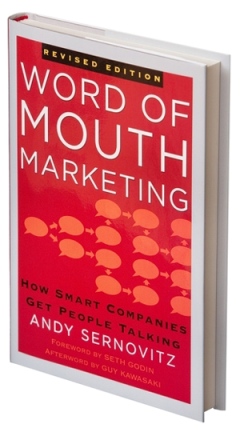 I recently interviewed Andy Sernovitz, founder of the Social Media Business Council, an organization that includes many of the world's largest brands such as Cisco, Coca-Cola, General Motors, Microsoft, Proctor & Gamble and Wells Fargo, just to mention a few.
I recently interviewed Andy Sernovitz, founder of the Social Media Business Council, an organization that includes many of the world's largest brands such as Cisco, Coca-Cola, General Motors, Microsoft, Proctor & Gamble and Wells Fargo, just to mention a few.
Andy is also author of the book Word of Mouth Marketing and founder of GasPedal, a group that advises big brands such as TiVo, Dell, Sprint and Kimberly-Clark.
During this interview, you'll gain insight into how large corporations are employing social media and you'll also gain Andy's insight into word-of-mouth marketing.
Word of Mouth Marketing & Social Media
 Mike: Let's go ahead and start with the first question. What exactly is word of mouth marketing, and how, if at all, is it any different than social media marketing?
Mike: Let's go ahead and start with the first question. What exactly is word of mouth marketing, and how, if at all, is it any different than social media marketing?
Andy: Word of mouth marketing is the art of getting people to fall in love with your brand. Getting them to be so thrilled and so turned on by what you do that they've got to tell people how awesome you are.
It's a series of tactical things that I teach in my book. It's a philosophy that says if we earn the respect and the recommendation of our customers, they'll do all of our advertising for free.
Mike: Because they become advocates for you, right?
Andy: Because they love you. This is the Southwest and the Starbucks and the Zappos. When people love a brand, they love to talk about those brands.
Social media is a subset of that. It is one tool you can use to make it easier for your fans to talk about you.
These days, we're really hot on social media. Everyone is saying, “Twitter, Twitter, Twitter.” We love the stuff, but we're starting to let the tool take over the purpose.
Mike: Just so I understand what you're saying, word-of-mouth marketing is about getting your customers, followers, or fans—whatever you want to call them—to love your brand so much that they're going to ultimately advocate for it and spread the word on your behalf, so you don't have to invest a lot of money.
And social media marketing is just a subset of that, which is leveraging these social media tools to do the exact same thing. Is that what I hear you saying?
Andy: Exactly. Social media is a great tool. I'm a huge user and fan, but it only applies to the online half of word of mouth. Even if you look at the online half, there are probably more recommendations happening by email than Twitter or all the other social media put together.
Word of Mouth Marketing Story
 Mike: That transitions really well into my next question. How has word of mouth marketing evolved, in your opinion, over the last decade? What do you think the catalysts have been?
Mike: That transitions really well into my next question. How has word of mouth marketing evolved, in your opinion, over the last decade? What do you think the catalysts have been?
Get World-Class Marketing Training — All Year Long!
Are you facing doubt, uncertainty, or overwhelm? The Social Media Marketing Society can help.
Each month, you’ll receive training from trusted marketing experts, covering everything from AI to organic social marketing. When you join, you’ll also get immediate access to:
- A library of 100+ marketing trainings
- A community of like-minded marketers
- Monthly online community meetups
- Relevant news and trends updates
Andy: We used to think word of mouth was luck. You did a good campaign, you did a good press release and it got buzzed—this magical word buzzed—and everyone was talking about you.
What's happened is we figured out that it isn't luck. It's a planned series of things that you do to get people talking. It's this idea that word-of-mouth marketing is similar to any other kind of marketing.
I guess what's new is the “marketing” part. “Word of mouth” is old. “Word of mouth marketing” is new.
Then we layered social media on that. Now we've got this big tool to take word of mouth that might have been one-to-one or one-to-two, and suddenly it's one-to-1,000 or one-to-50,000.
Mike: What did a typical word of mouth campaign look like a decade ago?
Andy: I don't think the word campaign would have been there. It wasn't word of mouth marketing yet. We didn't understand it's something that you can earn, that you can accelerate or that you can enhance. It just sort of happened.
Mike: The medium was probably email back then, right?
Andy: It was then, and probably is still today, more offline than anything.
If a friend tells you about a restaurant, you tell another friend about the restaurant. You go there for lunch with the office. Now everybody knows about it. Somebody emails a friend, somebody else posts a review, somebody else tweets it and somebody else puts it on Facebook. Then you read it on Facebook and you tell your spouse. Then you tell your coworkers.
The conversations weave in and out online and offline. None of these tools are the sole channel for one particular conversation. Your recommendations are flowing in and out of whatever format makes the most sense.
Word of Mouth Marketing Steps
Mike: What might be some of the word of mouth marketing steps at a very basic level?
 Andy: I like to talk about the five Ts. If you go to my blog, there's a download where you can get all of these written up, which is the framework for any kind of word-of-mouth campaign.
Andy: I like to talk about the five Ts. If you go to my blog, there's a download where you can get all of these written up, which is the framework for any kind of word-of-mouth campaign.
1. Finding the Talkers
Who is going to spread the word about you? They might be fans, customers, just people thrilled by who you or are maybe neighbors. There are all those people who could speak for you.
2. Giving Them a Topic
What are they going to say? That's unique to the product and the talker who's spreading the message.
Customers are saying something different than fans. Fans are saying something different than particular user groups. You have to find the topic that people love to repeat, that's easy to repeat, and that travels.
3. Tools
Tools are all these things we use to accelerate and extend the scale of the conversation.
Mike: Like Twitter, for example.
Andy: Everything social media falls in that tool bucket. But it's also something like the stickers that come with every Apple product. It's classic offline word of mouth. Everybody shares those stickers.
The tool can be a T-shirt. If your customers really want to put your logo all over their chest and run around and advertise you for free, they should have a T-shirt!
The tools are all the stuff of this. The tools are things that real estate agents love to do—the refrigerator magnets and the calendars and the rulers and all the other doodads. It's the stuff that lets the conversation travel.
4. Taking Part
Once people start talking about you, you need to respond, participate and become part of that conversation.
If you don't join the conversation, either the conversation ends or it goes negative because people think you're a snob.
5. Tracking
How do you measure this conversation, how do you measure the results and how do you drive through to your business objectives?
Mike: That's some brilliant simplicity to describe the components of what makes word-of-mouth marketing work.
Andy's Story
At what point in your career or in the last few years did you decide to focus on social media? What was the turning point for you that made you decide to focus on that?
Andy: There are two. Of the two brands that are part of my company, one is the GasPedal side, but we teach word-of-mouth marketing. It's the word-of-mouth marketing company.
Then on the SocialMedia.org side, we run the Social Media Business Council.
I think what happened is about 3 years ago, we realized that social media is something that anyone can get up and do. If you're a small business or an individual, it has that simplicity.
But when you're a big company, it gets so much harder. It requires significant philosophical, behavioral and operational changes. It's just not the same inside a major enterprise.
We started this group to be the home base and the peer group for people at big companies who are using social media and want to learn how to adopt it and learn from each other and share. That's where this started.
Mike: Was this just about when Twitter was exploding in popularity or was it actually even a little bit before then?
Andy: Twitter had just begun. We started in the summer of '08.
Mike: I think it was really about 18 months ago when Twitter started exploding in a massive way. Then Facebook, of course, just a few months behind, started exploding as well. It seems like you were a bit ahead of the curve.
Did you get there because you started to hear some of your clients on the GasPedal side saying, “We're starting to hear a lot from our customers about this social media stuff, and we need to get onboard” or had you seen this coming for a while?
Andy: It's interesting. Our name used to be the “Blog Council” because blogs were the only thing. Social media hadn't really become part of the mix yet.
We were at Dell headquarters and Dell was doing what they then called a “buzz marketing” conference. Dell had been inviting other companies over to learn how they ran their blogging, social media and conversations department.
I was at lunch with some folks from Dell, Proctor & Gamble, Microsoft and Intuit. We had been sharing our unique challenges with this stuff. We had been talking to each other informally, ending up with “Why don't we start a group that lets us formalize the sharing, scale it up, and bring a whole lot of companies together?” That was the formation.
Social Media in Business
Mike: That's incredible. I’m imagining social media has grown into a very popular tool for a lot of these huge corporations now. Do you agree with that?
Andy: I think every company is using it. What's most interesting is that the marketing side is such a small part of where social media adds value. It's really becoming transformative across the entire enterprise. HR is using it, customer service is using it, research is using it and internal communications is using it.
Mike: Do you find it's often starting from marketing and then spreading to other parts of the organization?

Discover Proven Marketing Strategies and Tips
Want to go even deeper with your marketing? Check out the Social Media Marketing Podcast! Publishing weekly since 2012, the Social Media Marketing Podcast helps you navigate the constantly changing marketing jungle, with expert interviews from marketing pros.
But don’t let the name fool you. This show is about a lot more than just social media marketing. With over 600 episodes and millions of downloads each year, this show has been a trusted source for marketers for well over a decade.
Andy: I would say with 50% of the companies, it starts in PR, which actually makes a lot of sense when you think about PR being much more structured for conversation. You build relationships with reporters, you tell stories and you build long-term dialogues. It's about words, whereas marketing is about numbers and campaigns.
Mike: You've spoken to a lot of big brands when it comes to social media. What are some of the important challenges today that many of these big brands are facing and how are you suggesting they deal with those challenges?
Andy: Probably the biggest challenge is what we call “Guffman,” as in the movie Waiting for Guffman. Everyone is waiting for this special person to show up and be in charge.
In a big company, every department gets it. They know what to do and they want to start using it, but then, “Is the Twitter account for the PR department or should HR use it or are the marketing guys going to use it? Is our Facebook page going to be for campaigns for marketing or customer service?”
You get all of these people moving around in the company trying to figure out who runs it and owns it.
Mike: How do you recommend they deal with this issue?
Andy: It really depends on the nature of the business. A lot of really big companies have a center for excellence, which is a centralized council of folks from all different departments who become the governing or guiding voice of social media across the enterprise.
I think, less formally, it's about locking into wins. When it's working over here in this department, you do more of that. They tell the department next to them and they tell the department next to them. It's a series of small growing successes.
Dark Side of Social Media
Mike: Let's talk about the dark side of social media. There's a lot of hype around the phrase social media. Are there certain misconceptions, do you think, among businesses? Do they think it's the Holy Grail and can solve all their problems? Does it fall short in any particular areas? What are the downsides to social media, in your opinion?
Andy: People think it's an advertising technique and that it's about campaigns. If your ad guys take over your social media voice, you're in trouble. It's not a customer acquisition tool like, “What's our ROI?” It's a conversation tool.
If you start jamming what are really TV ads onto YouTube and calling it social media, it's not going to work. Equally important, you're going to miss the point.
Search has made us completely addicted to the numbers. We know to the 800th decimal point our search engine lead generation costs every second of every day. But we don't know if someone posted an Amazon review about our product that is going to sit right next to the Buy button forever.
Thinking about social media as advertising is really where the danger is.
Social Media Outsourcing
Mike: Let's talk about outsourcing. Do you think big businesses can outsource their social media activities? If so, what kind of transparency needs to be in place? What are your thoughts on outsourcing social media?
Andy: It's hard to do a lot of it outsourced. There's a reason why our group is a ‘brands only' group. We can talk about these things without the agencies in the room.
The mechanics, you can outsource.
Mike: The Twitter background or something like that.
Andy: Yes, setting it up and doing the creative, some of the heavy lifting on the execution, the analytics and all of that kind of stuff.
But what we're talking about is fundamentally your customer voice, your brand voice, and your personality. The whole point of this is to connect with people and talk to people. How do you outsource being friends with someone?
And if you think you went bad with all of the tech support that went overseas where everyone just tried to save a buck and it was a disaster for any brand who did it, imagine when your brand is being represented by somebody who's only in it as long as their agency has the account.
There are exceptions. There are great agencies and PR firms that have long-standing customer relationships with their clients, where the agency is speaking with the customer voice and has been doing it for years and knows how to do it.
Mike: Do you think there needs to be any kind of transparency or do you think that's not necessary when it comes to this kind of outsourcing if a big company does choose to outsource some aspects of this?
Andy: I am the single biggest advocate and maniac when it comes to absolute transparency all of the time. You'll see me running all around the country pounding the podiums screaming about ethics because this is what it all comes down to. You can't build a trust-based relationship that starts with lying to somebody about who you are.
Mike: How would you go about doing this then? If big brands are outsourcing certain aspects—let's say they have a bunch of Twitter accounts and one of them is maintained by an outsourced agency—how would they disclose that kind of detail?
Andy: It's surprisingly simple. You say, “Hey, I'm working at so-and-so helping out with branding.”
Everyone thinks this transparency thing is hard. It's really easy. “Hi, I'm on Brand Company's team over at the such-and-such agency. How can I help?”
It's a phrase that goes from total lack of disclosure to complete transparency.
Social Media Success Story
Mike: Let's talk about a company that's doing social media marketing. Is there any one particular standout story or company you think is doing it really well? Who are they and what are they doing right?
Andy: I think Starbucks is doing a fantastic job right now.
Mike: What do you think they're doing right? They've been getting an enormous amount of press regarding their Facebook content. I'm trying to figure out if it's because they're a big brand. Is it the “Ford” effect? Ford was one of the first big brands to get on Twitter, thus they got all the focus of the press. Is it the same deal with Starbucks and Facebook, or is there something more going on here?
Andy: Starbucks uses social media like it's supposed to be used. They have a big team of smart people who are out there every day talking to folks. Their followers are earned because they love the brand, they love the products and they love the people they talk to.
When you become a friend of Starbucks on Facebook or you follow them on Twitter and start having conversations, it's really awesome. That begets more which begets more and that's how this stuff happens.
Mike: Do you think part of the reason they're so successful is because they already had a loyal, crazed fan base to begin with, and Facebook and Twitter just allowed them to come together?
Andy: Yes, this goes back to the sort of framework for word of mouth.
People love Starbucks, but it's hard to have six people in Seattle talk to 150,000 friends every day until you add the social media tools. Suddenly, you can have relationships with lots of people—meaningful relationships—and you can do it with science.
It's interesting. They presented a case study at our last conference. They did a new Facebook page and Twitter accounts for Frappuccino®, which is a very new brand, separate from the Starbucks Facebook and Twitter pages. Millions of people went from being fans of Starbucks to fans of Frappuccino. That kind of transition doesn't happen unless people were enjoying the first relationship and they found it beneficial and meaningful, or they wouldn't have bothered to friend a sub-product.
Mike: Do you know whether Starbucks is actually encouraging people to participate by putting on the cups “Join us on Facebook” or that kind of stuff?
Andy: I don't know.
Mike: It may just be that their brand was so great to begin with, and then they applied a really great strategy to it that has exploded. It certainly seems as though it follows the five Ts that you're talking about.
Are there any B2B brands you can think of that are doing social media well?
Andy: There are a lot of good brands. Some of the big ones, some of the pure-plays are Intel, Cisco, SAP and a lot of those tech brands. I forget the exact number, but SAP is picking up something like 20,000 new members of their communities per month. That's a lot of people.
Future of Social Media
Mike: Let's look to the future. Where do you see this whole social media thing going in the next couple of years? Do you think the words social media are going to be obsolete? Do you think there's some new stuff coming on the horizon?
Andy: I think it will get normal. We'll stop thinking of it as “media.” That's a bad word. It implies it's something you buy to get your message out.
Mike: It will be another channel as ubiquitous as email or the fax machine.
Andy: Yes.
Mike: For those businesses that are just now getting started with social media, what would be the single piece of advice you would give them, even if they are a mid-sized or small corporation?
Andy: It's the same advice for everybody, which is to just do the little stuff. Pick one thing you can do—whether it's a Facebook page or a Twitter account or one particular product—and keep it really simple. Don't spend any money. You'll find it's surprisingly easy and you'll have some nice overall results. All of the politics and the fears and the objections that are getting in the way, they all go away because you can prove that it worked.
More Word of Mouth Marketing
Mike: Andy, this has been a really exciting and interesting conversation. If folks want to learn more about you and your organization, where might they go?
Andy: If you want to learn word of mouth marketing, go to GasPedal and check out our Word of Mouth Supergenius conference, our blogs, newsletters and the like.
If you want to learn about social media for big business, go to SocialMedia.org.
Mike: Andy, I really appreciate you taking some time out of your schedule today and I wish you the best.
Andy: Thanks for having me.
Listen to the full interview below to hear more from Andy.
[audio:AndySernovitz.mp3]What do you think about this interview? Do you agree with Andy? Leave your comments in the box below.
Attention Agency Owners, Brand Marketers, and Consultants

Introducing the Marketing Agency Show–our newest podcast designed to explore the struggles of agency marketers.
Join show host and agency owner, Brooke Sellas, as she interviews agency marketers and digs deep into their biggest challenges. Explore topics like navigating rough economic times, leveraging AI, service diversification, client acquisition, and much more.
Just pull up your favorite podcast app, search for Marketing Agency Show and start listening. Or click the button below for more information.

